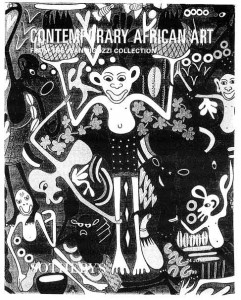Two recent, fine, contrastive exhibitions in London’s premier art district showcased work by three established artists from Tanzania: Robert Glen, Georges Lilanga and Sue Stolberger. The first was ‘Contemporary African Art from the Jean Pigozzi Collection’ at Sotheby’s; the front cover of the illustrated 132-page catalogue shown here is a reproduction by Tanzanian artist Georges Lilanga di Nyama at the exhibition entitled Uishi na jirani zako vizuri ili ukipatwana shida watakusaidia (maintain good relations with your neighbours so they will help you when you are in trouble) Acrylic on plywood 1992. The second was ‘Robert Glen and Sue Stolberger: Tusk Trust Exhibition’ at the Tyron & Swann Gallery in Cork Street in London. There was a 14-page illustrated catalogue.
With East African childhoods, the three artists describe themselves as self-taught, that is without an academic art education; nonetheless Glen and Lilanga have at times run their own workshops. It was a rare opportunity during one week to see familiar kinds of Tanzanian art -European wildlife naturalism and Makonde social imagery.
Tyron & Swann, a commercial gallery that specialises in natural life subject matter, showed some 50 objects comprising 14 bronze sculptures by Glen and 37 water-colour paintings by Stolberger. Their realistic art is inspired by the ‘uninhabited wilderness’ of Ruaha National Park, their home and studio for the past five years. Their works are complementary. Stolberger’s paintings express the changing scene –dry environment, big skies and also the small, designer details of animals and birds (often depicted together, like Robin A’s batiks from Nairobi). Glen’s sculptures fill out the space with the eternal gestures of animals; bronze is permanent and such objects exude a powerful presence. Glen’s mastery of subject and medium are superb; it makes me wonder about links to his original profession of taxidermy -in the 60’s.
The Sotheby’s exhibition, in contrast, was a group show of Contemporary African Art from the Collection of Jean Pigozzi and part of their first ever auction in this genre (Sotheby’s expertise is African ‘tribal’ art; Pigozzi’s Collection has been shown in the UK previously at prime Modernist white walled venues such as the Saatchi, Serpentine and Tate, Liverpool; ironically the gallery walls were painted mud brown). The show of 28 artists featured four paintings inclusive of the catalogue cover. Georges Lilanga di Nyama who was born in Masasi and is a practised Makonde carver, co-founded the Nyumba ya Sanaa (House of Art) in Dar es Salaam in the early 70’s. His major achievement is the transformation of Makonde shetani (spirit) imagery into two-dimensional forms for prints and paintings; a touch of nationalism is his insistence on Swahili titles. He acknowledges ‘Tinga Tinga’ (Eduardo Saidi 1937-72 at Morogoro Stores) who introduced him to painting with domestic paints on square, plywood boards. I find Lilanga’s imagery is more original, organised and dynamic than that found on most ‘square’ paintings.
The auction sales were successful beyond predictions; only one of 57 works did not ‘go’. Lilanga’s paintings fetched between £6,000 -£8,200 (3 to 4 times the asked price); the average was £4,000 and the highest price was £11,200.
For me, viewing these works was evocative, recalling work in and visits to Tanzania while also affirmative of the ongoing contribution of art to cultural identity, if not development. Indeed, for both venues, percentages of the proceeds are being shared; from the Tyron & Swann Gallery with the Tusk Trust and Friends of Ruaha Society and from the Sotheby’s Pigozzi auction with UNICEF and an artists’ fund. Maendeleo na Sanaa.
Elsbeth Court


Pingback: Tanzanian Affairs » 36 YEARS OF TANZANIAN AFFAIRS – PART 2